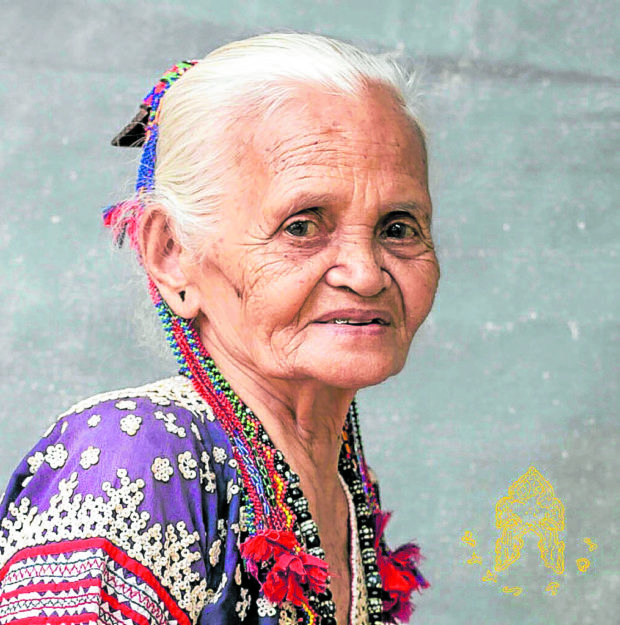
POLOMOLOK, South Cotabato — Yabing Masalon Dulo, Blaan master weaver, lived beyond a century and left a legacy that inscribed her far-flung tribal community in the country’s culture and arts landscape.
Fondly called Fu Yabing, she was a revered bai or princess in their tribal community that thrived for centuries in an enclave at the foot of Mt. Matutum. That is where she honed her craft. (Fu is an endearment used by a nonfamily member to address an old Blaan woman, like lola for Tagalogs.)
She peacefully died in her sleep before dawn on Jan. 26, at her home in Sitio Amgu-o, Barangay Landan. She was 106.
The passing of Fu Yabing, who was born on Aug. 8, 1914, was mourned not only by her community but the nation as well. She was declared national living treasure or recipient of the Gawad sa Manlilikha ng Bayan on Jan. 6, 2017, an award conferred by President Duterte in a ceremony at Malacañang Palace the following year.
She was a master of mabal tabih, the art of ikat (reserve dyeing) and weaving. Mabal is a Blaan term for the weaving process using abaca fibers while tabih refers to the finished handwoven cloth and also the traditional Blaan tubular skirt.
Meticulous process
Her death, however, does not mean the end of her legacy. Fu Yabing imparted her knowledge of mabal tabih weaving to the women of the Lamlifew School of Living Tradition in Malungon, Sarangani, which has become a tourism destination.
Her students have gone beyond the country’s borders to other countries while art and culture enthusiasts come by to buy their products.
The mabal tabih can be used as décor on the wall or glass-top or can be fashioned into albung ansif (embroidered blouse) or dafeng (malong or tubular skirt).
They don’t come cheap, though. A small tabih (4 meters by 12 inches) fetches P6,000 and the bigger one (4 m by 30 inches) at P15,000.
“[The making of] mabal tabih is a meticulous process that takes three to four months to finish for those who are not in the caliber of my grandmother,” Arthur Gulili, Fu Yabing’s grandson, told Lifestyle.
Fu Yabing’s intricate designs usually incorporate crocodiles and lizards, reptiles she had seen in her youth when their community—now accessible through a paved road—could be reached only by foot or on horseback. Black, red, yellow and orange tend to dominate the colors of her work.
“She made sure that the mabal tabih weaving tradition will not vanish by sharing her mastery of the craft with the younger generation. That’s the greatest legacy she left us, and we the Blaans will be forever grateful and proud of her,” said Gulili, 33.
“Her peerless mastery of the Blaan mabal tabih is manifest in her impeccable work,” the National Commission for Culture and the Arts (NCCA) said, as the government agency announced her passing. “Her exemplary oeuvre has brought pride to her community, animating the interest of many young Blaan in their remarkable cultural heritage,” the NCCA wrote.
Conveying a tradition
Marian Pastor Roces, an art critic and curator based in Manila, also hailed Fu Yabing for “single-handedly staying the course of Blaan ikat-dyeing, conveying a tradition to the 21st century.”
Lamina Gulili, the only daughter among Fu Yabing’s four children, said the master weaver learned the craft from her mother. “When she was still young, she observed her mother doing the art of ikat weaving until she was doing it herself and had mastered the craft through years of regularly producing the cloth,” Lamina said.
With Fu Yabing gone, Lamina is taking over the big role. But she also trained others in her community outside her family.
One of these students, Myrna Sarino, thanked Fu Yabing for sharing her knowledge.
“Even if you’re almost done and she saw something wrong [with your work] even if just minute, she would make you do it all over again,” Sarino said.
The 43-year-old Sarino started mabal tabih weaving in 2013 and has been invited by the NCCA for a seminar in Manila and to be part of an exhibit featuring their traditional cloth at a mall in the national capital. She was pleased when her daughters showed interest in weaving.
As a show of respect to Fu Yabing, the weavers in her community will halt their production for the duration of the wake. Community members prepared the multifunction hall where Fu Yabing will lie in state until her burial on Feb. 10.
Fu Yabing had been in and out of the hospital since last year due to illness.
She will be given a state funeral, including a 21-gun salute. Had she not been a national living treasure, she would have been buried immediately, unembalmed and without a coffin, the traditional Blaan way of burying their dead.
The mabal tabih weaving center, beside where Fu Yabing’s wake is held, is in a stage of deterioration. Her family had arranged for her to be buried there.
Even in death, Fu Yabing brought her craft with her. In her glass coffin, she’s clad in what else but mabal tabih, the cloth that immortalized her name in the cultural landscape of the country.